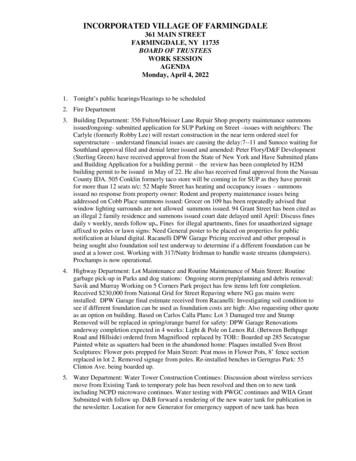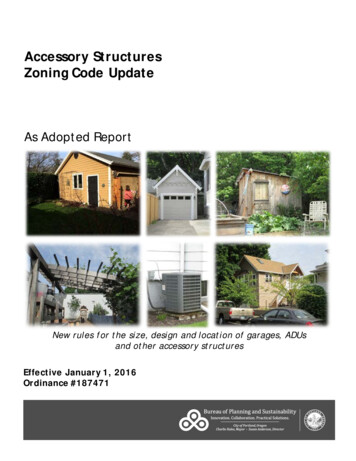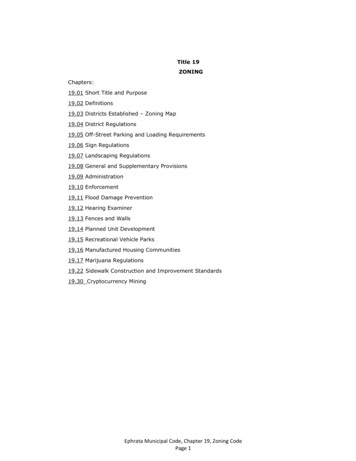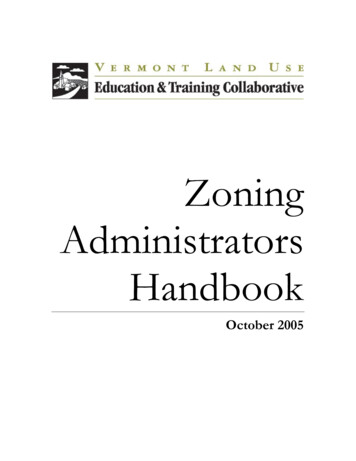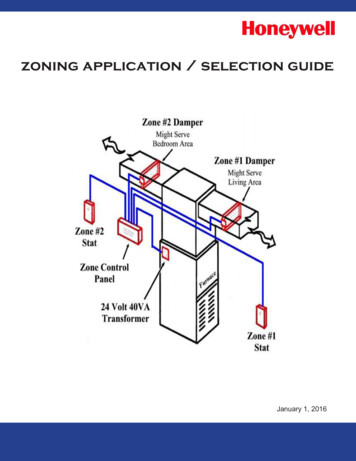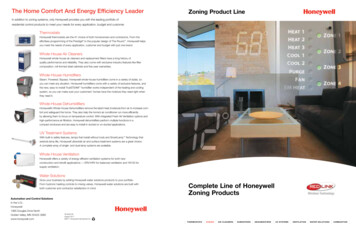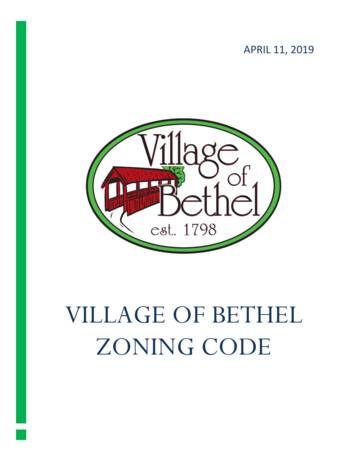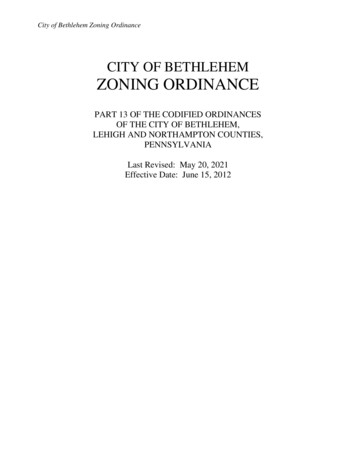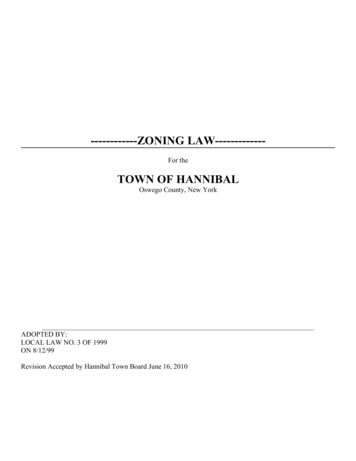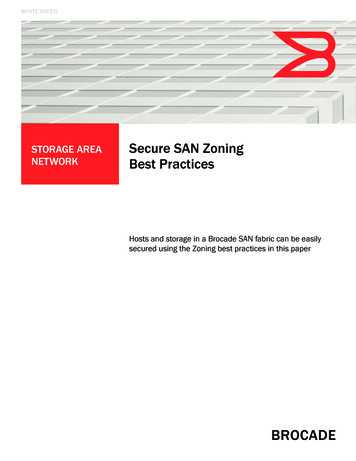
Transcription
WHITE PAPERSTORAGE AREANETWORKSecure SAN ZoningBest PracticesHosts and storage in a Brocade SAN fabric can be easilysecured using the Zoning best practices in this paper
This paper describes and clarifies Zoning, a security feature in StorageArea Network (SAN) fabrics. By understanding the terminology andimplementing Zoning best practices, a Brocade SAN fabric can beeasily secured and scaled while maintaining maximum uptime.The following topics are discussed: Zoning defined and LUN security in the fabric Identifying hosts and storage members of a zone How do SAN switches enforce Zoning? Avoiding Zoning terminology confusion Approaches to Zoning, how to group hosts and storage in zones Brocade Zoning recommendations and summaryWhat is Zoning?Zoning is a fabric-based service in Storage Area Networks that groups host and storage nodesthat need to communicate. Zoning creates a situation in which nodes can communicate witheach other only if they are members of the same zone. Nodes can be members of multiplezones--—allowing for a great deal of flexibility when you implement a SAN using Zoning.Zoning not only prevents a host from unauthorized access of storage assets, but it also stopsundesired host-to-host communication and fabric-wide Registered State Change Notification(RSCN) disruptions. RSCNs are managed by the fabric Name Server and notify end devices ofevents in the fabric, such as a storage node or a switch going offline. Brocade isolates thesenotifications to only the zones that require the update, so nodes that are unaffected by thefabric change do not receive the RSCN. This is important for non-disruptive fabric operations,because RSCNs have the potential to disrupt storage traffic. When this disruption was morecommon, that is, with older Host Bus Adapter (HBA) drivers, RSCNs gained an undeservednegative reputation. However, since that time most HBA vendors have addressed the issues.When nodes are zoned into small, granular groupings, the occurrences of disruptive RSCNsare virtually eliminated. See a discussion of single HBA zoning in the section of this paperentitled, “Approaches to Zoning.”2
LUN Security in the FabricRSCNs and ZoningThe most basic function of a SAN is to connect hosts to storage. The unit of storage for moststorage arrays is the Logical Unit Number (LUN), a partition of a single drive or a RAIDprotected set of drives. Multiple LUNs are mapped to Fibre Channel (FC) ports on the array.Currently, Zoning is almost always used to group storage ports and hosts. Zoning used byitself allows a host access to all of the LUNs presented to a particular storage port on anarray. LUN masking, which can be performed via the HBA or more commonly via the storagearray, ensures that the authorized host has access only to a defined set of LUNs presentedby each storage port. LUN masking could be used exclusively to map LUNs to hosts, but thiswould expose every host to every RSCN in the fabric, which compromises stability. Zoning andLUN masking combine to provide two layers of security, to prevent inappropriate access to aLUN even when one layer is misconfigured.BEST PRACTICE: Always implement Zoning, even if you use LUN masking.Identifying Hosts and Storage zone MembersWhen configuring Zoning, nodes must be identified and grouped. How the nodes areidentified can affect the following: How well the Zoning configuration will scale How some advanced features are configured What processes are required if an HBA needs to be replacedRSCNs do not cause broadcast storms,because they use a direct, unicast addressinstead of the broadcast address used inthe Ethernet world. HBAs discard RSCNsunless the HBA is the specific destinationfor the RSCN message. In a worst casescenario, a single device could be floodedwith RSCNs, but this does not extend toevery device in the fabric. In versions ofFabric OS (FOS) prior to 4.4.0, RSCNswere sent during a fabric reconfiguration,and HBAs would sometimes erroneouslyabort and then retry I/Os after a 30second pause from a SCSI timeout. Thisbehavior changed in FOS 4.4.0 (releasedin September 2004), and Brocade nolonger sends an RSCN during a fabricreconfiguration. For more details on RSCNsand other SAN availability characteristics,contact your Brocade representative forpapers entitled, “Availability in SANs andLANs” and “Brocade RSCN Events Matrix.”Types of ZoningThere are two types of Zoning identification: port World Wide Name (pWWN) and Domain,Port(D,P). You can assign aliases to both pWWN and D,P identifiers for easier management. ThepWWN, the D,P, or a combination of both can be used in a zone configuration or even in asingle zone. pWWN identification uses a globally unique identifier built into storage and hostinterfaces. Interfaces also have node World Wide Names (nWWNs). As their names imply,pWWN refers to the port on the device, while nWWN refers to the overall device. For example,a dual-port HBA has one nWWN and two pWWNs. Always use pWWN identification instead ofnWWN, since a pWWN precisely identifies the host or storage that needs to be zoned.D,P identification uses the switch domain ID and switch port to identify zone members. UntilFabric OS 5.2.0, the “P” in D,P was equal to the port area ID and ranged in value from 0 to255. Since the Brocade 48000 48-port blade requires the value of P to range from 0 to 383,P is now equal to the port index for a port. Since the use of port index instead of area ID isrequired when using D,P identification on a 48-port blade, all switches in the fabric must berunning Fabric OS 5.2.0 or greater. Note that D,P identification is not globally unique (asshown in Figure 1), since every fabric can have duplicate domain IDs and every switch has aport index of 1, 2, 3, and so on. Any device cabled to a zoned D,P can communicate asdefined by the zone configuration. The only identification method that is unique for all fabricsis pWWN.Figure 1.D,P identification is not globally unique.Domain ID 2Domain ID 3Domain ID 1Domain ID 1The red fabric has a Brocade 48000 with 32-port blades.The D,P identifier for port 64 is 1,63.The black fabric has 2 x Brocade 200Es and a 4900.The D,P identifier for port 64 on the 4900 is 1,63.3
If an HBA or storage port fails, the Zoning configuration may have to be adjusted toaccommodate a new pWWN when the replacement device does not allow its pWWN to beprogrammed. With D,P identification, a failed HBA or storage port just needs to be replaced—no Zoning changes are required—since the D,P identification allows any pWWN connected toswitch port D,P to communicate with other members of its zones. With pWWN identification, adevice can be cabled to a different switch port without impacting the Zoning, since the pWWNfollows the device and not the switch port.pWWN identification can be more secure than D,P identification, because any devicephysically cabled to a port could inappropriately grant storage access to an unauthorizedhost. Environments that allow multiple users access to switch ports and that have limitedor no physical access monitoring should not use D,P identification because of the risk ofunauthorized hosts being cabled to the wrong switch port.SecurityWhile pWWN identification prevents unauthorized Zoning access when cables are moved, itis possible to spoof a pWWN and thereby gain access to a zone using pWWN access. For thisto happen, a device must be attached to the fabric and the spoofing attacker must choosea pWWN that has a zone to the node that is being attacked. Although this process would bevery difficult, it would be possible, since fabrics do not reject duplicate logins, in accordancewith Fibre Channel standards. This means that the spoofed pWWN would be allowed to jointhe fabric even if the legitimate pWWN were already logged in to the fabric.The possibility of spoofing pWWNs can easily be reduced if you define Device ConnectionControl (DCC) policies (also known as “Port ACLs”). DCC policies map a pWWN to a physicalswitch port; then, if a pWWN tries to log in to a port not allowed by the DCC policy, the pWWNlogin is rejected. The DCC policy enforcement occurs before Zoning, since DCC controlsdevice login and not which devices can communicate. To completely eliminate the risk ofWWN spoofing, Diffie-Hellman Challenge-Handshake Authentication Protocol (DH-CHAP)authentication can be implemented. DH-CHAP enforces strong authentication between thehost and switch when the host logs in to the fabric. The best approach for securing devicescommunicating in a fabric requires a combination of Zoning using pWWN identification, DCCpolicies, and DH-CHAP device authentication.For ease of operation, use a single identification method. While pWWN and D,P identificationcan be mixed in a Zoning configuration or a zone, this can lead to configuration errors,because different processes are required for each method. Also, with mixed identificationmethods, a failed HBA may require Zoning and DCC modifications.BEST PRACTICE: Use pWWN identification for Zoning for both security and operationalconsistency.Advanced FeaturesSome advanced Brocade features, such as Fibre Channel Routing (FCR) and Fibre ChannelWrite Acceleration, use pWWN identification. For example, FCR allows zones to be createdbetween independent fabrics using the Brocade 7500 SAN Router and/or Brocade FR4-18iRouting Blade. The routers analyze the zones in each fabric and allow nodes to communicatebetween the fabrics only if zones exist in both fabrics containing the relevant pWWNs.Since Brocade FCR technology uses Zoning, pWWNs must be used to uniquely identify themembers of the routed zones. D,P identification cannot be used since non-unique pairs ofnodes cannot be zoned, for example, domain ID 1, port ID 1 in fabric 1 cannot be zoned withdomain ID 1, port ID 1, in fabric 2. Even if a fabric does not use FCR today, you should stilluse pWWN identification in the event that FCR is ever introduced to the fabric. In this way, asingle, consistent identification method can be used for local, non-routed zones and zonesthat are routed between fabrics.4
Domain ID 2Port 64D,P 1,63Storage pWWN10:00:00:05:1e:12:34:56DomainID 1Brocade 48000with 16-port bladesFigure 2.Fibre Channel Routing with pWWNversus D,P.Domain ID 1Host pWWN10:00:00:05:1e:78:90:12Port 64D,P 1,63LSAN 12LSAN Brocade 7500 SAN RouterAs shown in Figure 2, the only identification method that is unique for all fabrics is pWWN.Storage or host pWWN connected to each port 64 in each fabric is unique.Enabling LSAN BLACK1 in the black (right) fabric and LSAN RED1 in the red (left) fabriccauses the Brocade 7500 SAN Router to allow those two pWWNs to communicate, whilekeeping the red and black fabrics separate and unmerged.NOTE: The unused ports on the Brocade 7500 SAN Router are not part of either fabric.VirtualizationUsing pWWN identification is also important if you are implementing the Brocade AccessGateway feature, which uses the N Port ID Virtualization (NPIV) protocol to remap server HBAN Ports to external switch ports that act as N Ports. Zoning the server HBA N Ports must bedone by pWWN, since a switch in Access Gateway mode, unlike a regular fabric switch, doesnot have a domain ID for use in D,P identification. Additionally, server Operating System (OS)virtualization software uses the NPIV protocol to allow virtual machines to have virtual HBAs.Zoning to these virtual HBAs must be done using the virtual pWWN for the virtual HBA.Figure 3.pWWN identification for Access Gatewayand server OS virtualization using NPIV.Blade Server ChassisBrocade 4900Blade Serverhost pWWN10:00:00:05:1e:78:90:12BladeNserverAccess NGatewayNNoDomain ID NF Brocade4900F externalFFswitchDomainID 15
There is no Domain ID associated with a blade switch in Access Gateway mode, so D,Pidentification cannot be used. pWWN identification must be used when zoning hosts switchedby a device in Access Gateway mode.Regardless of the Zoning identification, unused ports should be persistently disabled. Also,ports that are connected to storage and host devices should have their E PORT functionalitypersistently disabled. See the Brocade white paper, “The Growing Need For Security inStorage Area Networks,” for more information (available on www.brocade.com).BEST PRACTICE: Use pWWN identification for all Zoning configuration unless specialcircumstances require D,P identification (for example, FICON).Naming ConventionsNaming conventions are very important to simplify Zoning configuration management for SANadministrators. Aliases for pWWNs, zone names, and zone configuration names can be verydetailed, but can be designed in a user-friendly fashion. User-friendly alias names ensurethat zone members can be understood at a glance and configuration errors minimized. Keepin mind also that the size of the Zoning database is not unlimited. In very large SANs, keepalias and zone names short to maximize the number of Zoning database entries. In Fabric OS5.2.0 or later, a maximum Zoning database size of 1 MB is supported (four times larger thanthe previous Fabric OS maximum). You can check the size of the database by running thecfgSize command.NOTE: If an older Fabric OS switch is present in a fabric, the maximum database size isreduced to the smallest common denominator for all switches in the fabric.BEST PRACTICE: Make Zoning aliases and names only as long as they need to be—whichenables maximum scaling (for very large fabrics, such as a FOS 5.2.0 and later fabric with5000 ports).How Do SAN Switches enforce Zoning?Now that node identification has been reviewed and zones have been created and activated—how does the switch actually enforce the defined zones? Brocade implements two methods: Frame-based hardware enforcement Session-based hardware enforcementAdvanced FeaturesAlthough software enforcement has been used by Brocade in the past, Brocade Fabric OSsupports only hardware-based enforcement of Zoning. These scenarios are covered in detailbelow.Software enforcement occurs when the Name Server service in the fabric masks the NameServer entries that a host should not access. When the host logs in to the fabric, it discoversonly the unmasked Name Server entries. This “security through obscurity” technique dependson hiding the existence of certain storage targets from certain hosts. There is no mechanismwith software-enforced Zoning that prevents a host from accessing storage.For example, if a host was zoned to storage ports 1, 7, and 10 and the SAN administratorremoved storage port 7 from the host’s zone, the host would still know that storage port7 was on the fabric and it would know the route to the port. Since software enforcementdepends on hosts logging in to the name server to learn about storage targets, a host thatdoes not log back in after a Zoning change can still access storage targets known from theinitial login. Some HBAs will continue to access a storage port with software-enforced Zoningeven though access was removed. (This should be much less common as HBA drivers havebeen improved over the years.) Note again that Brocade Fabric OS supports only hardwareenforcement of zones.6
Hardware enforcement is performed by the Application-Specific Integrated Circuits (ASICs)in fabric switches. Unlike software enforcement, hardware enforcement is a proactivesecurity mechanism. Every port has a filter that allows only the traffic defined by the Zoningconfiguration to pass through. If traffic disallowed by the Zoning configuration is initiated,the ASIC will discard the traffic. Hardware enforcement is much more secure than softwareenforcement, because it does not depend on the “good citizen” behavior of the server HBA.Even if the host has knowledge of a storage port, hardware enforcement can proactivelyblock any attempt to access that port.The type of Zoning enforcement is determined on a zone-by-zone basis and depends onhow the Zoning identification is configured. A zone can contain all pWWNs, all D,Ps, or acombination of pWWNs and D,Ps. An alias can be created for a pWWN or D,P and will act justlike the aliased item for enforcement purposes.In addition, an overlapping zone occurs when, for example, a pWWN is in Zone1 and, the D,Pthat this pWWN is cabled to, is in Zone2. Both zones are considered to overlap, as shown inFigure 4. pWWN1 is cabled to D,P1 Zone1 (pWWN1; pWWN2; and so on) Zone2 (D,P1; D,P2; and so on) Both Zone1 and Zone2 overlapZone1 with pWWN identification:Zone1 Host1 Storage (10:00:00:05:1e:12:34:56; 10:00:00:05:1e:78:90:12)Storage pWWN10:00:00:05:1e:12:34:56Zone2 with D,P identification:Zone2 Host2 Storage (1,15; 1,0)Domain ID 1Host1 pWWN10:00:00:05:1e:78:90:12Figure 4.If a Zoning configuration containing bothZone1 and Zone2 is enabled, the zones willoverlap since the pWWN and D,Ps of thestorage are used in separate zones.Port 0: StoragePort 8: Host1Port 15: Host2Brocade 4900Host2 pWWN10:00:00:05:1e:34.56.78Brocade still performs hardware enforcement on overlapping zones but enforcement issession-based and not frame-based.Frame-based hardware enforcement occurs in the following cases on a per-zone basis: All zone members in a configuration use pWWN identification All zone members in a configuration use D,P identification Zones use either pWWN or D,P per zone with no mixed or overlapping zonesSession-based hardware enforcement occurs in the following cases on a per-zone basis: A mixed zone with both pWWN and D,P members Any overlapping zones7
To ensure that all Zoning implements frame-based hardware enforcement, use pWWN or D,Pidentification exclusively. pWWN is more secure than D,P because of physical security issuesand it enables the use of FCR, FC FastWrite, Access Gateway, and other features.BEST PRACTICE: All zones should use frame-based hardware enforcement; the best way todo this is to use pWWN identification exclusively for all Zoning configurations.Avoiding Zoning Terminology ConfusionOver the years, many terms have evolved to describe Zoning, some of which confuse thetrue nature of the Zoning method in question and lead to incorrect beliefs about howZoning actually works. The most significant error made in describing Zoning is associatingthe identification method with how Zoning is enforced. With Brocade 1 Gbit/sec Fabric OSswitches, only D,P identification was hardware enforced. This led to the term “hard zoning”being associated with D,P identification; D,P is also called “port zoning.” pWWN identificationon Brocade 1 Gbit/sec Fabric OS switches was software enforced, so the term “soft zoning”came into the SAN lexicon in addition to “WWN zoning.”Once Brocade released 2 Gbit/sec FOS switches, pWWN identification became hardwareenforced, so the older association of pWWN identification with software enforcement and D,Pwith hardware enforcement became technically obsolete. But the terms “hard” and “soft”persisted with the incorrect belief that using the D,P identification was more secure thanusing the pWWN identification. Today, Zoning should be viewed as a security mechanismfor SANs with two identification options and three enforcement methods. The relationshipto identification and enforcement was outlined earlier, but for recent switches all Zoningis hardware enforced. This is true for switches and directors running Brocade Fabric OSand Brocade M-EOS operating systems. The old terminology of “hard” and “soft” shouldbe abandoned in favor of specifying enforcement and identification. For example, usestatements such as “ the Zoning for this fabric is all frame based and hardware enforcedusing pWWN identification.” or “ the Zoning is frame based and hardware enforced usingpWWN except for some session-based, hardware-enforced overlapping zones.”BEST PRACTICE: Describe Zoning by enforcement method and identification type, that is,pWWN or D,P with hardware (frame- or session-based) or software enforcement. Abandonterms such as “hard” and “soft” or “port” and “WWN” Zoning. Brocade performs only frameor session-based hardware enforcement.Approaches to ZoningThere are many ways to group SAN host and storage nodes for a particular Zoningconfiguration. Zone membership is primarily based on the need for a host to access astorage port. Hosts rarely need to interact directly with each other and storage ports neverinitiate SAN traffic by virtue of their nature as targets. Zones can be grouped by array, by hostoperating system, by application, or by location within the data center. In most cases, none ofthese methods is recommended for the reasons outlined earlier.The recommended grouping method for Zoning is Single Initiator Zoning (SIZ), sometimescalled “Single HBA Zoning.” With SIZ, each zone has only a single HBA and one or morestorage ports. If the HBA has both disk and tape storage devices, then you need to create twozones: one zone with the HBA and the disk devices and a second zone with the HBA and thetape devices. SIZ is optimal because it prevents any host-to-host interaction and limits RSCNsto just the zones that need the information within the RSCN.Separating the disk and tape devices into separate zones prevents disk RSCNs fromimpacting tape devices, which tend to be more sensitive to RSCNs. While this level of Zoningmight seem to be more labor-intensive compared to less granular grouping methods, itlays the best foundation for SANs, and will ultimately increase uptime and reduce the timerequired to troubleshoot problems.BEST PRACTICE: Use single HBA Zoning with separatezones for tape and disk traffic when an HBA is carrying both types of traffic.8
BEST PRACTICE: Use Single Initiator Zoning with separate zones for tape and disk trafficwhen an HBA is carrying both types of traffic.When no Zoning configuration is enabled, the default zoning access level can be either open,with all nodes seeing all other nodes, or closed, with all nodes isolated. This state is calledthe default zone and it describes the state of a fabric if no Zoning configuration is enabled.For Brocade M-EOS fabrics, the default zone is set to disallow any communication in thefabric if no Zoning configuration has been performed. This very secure default setting limitsunintentional node communication on an unconfigured SAN or during the time betweendisabling and enabling Zoning configurations.For Brocade Fabric OS fabrics, the default zone can be optionally set to behave in the sameway as the default zone in M-EOS fabrics. By default, Fabric OS fabrics have no default zone,which means that all nodes can communicate if no Zoning configuration has been performedor no Zoning configuration is enabled. To prevent this and make the Fabric OS SAN behavelike an M-EOS SAN with default no access, enable the default zone with the -- noaccesssetting. Additionally, there is a small period of time that occurs when disabling one zoneconfiguration and enabling another during which all nodes can communicate by default ina Fabric OS fabric. This small period of time can, however, be disruptive in large fabrics,so it is important to implement a default zone with a --noaccess setting in large Fabric OSenvironments.BEST PRACTICE: Implement default zone --noaccess in Fabric OS fabrics.SummaryZoning is the most common management activity in a SAN. To create a solid foundation for anew SAN, adopt a set of best practices to ensure that the SAN is secure, stable, and easy tomanage.The following recommendations comprise the Zoning best practices that SAN administratorsshould consider when implementing Zoning. Always implement Zoning, even if LUN Masking is being used. Always persistently disable all unused ports to increase security and avoid potentialproblems. Use pWWN identification for all Zoning configuration unless special circumstances requireD,P identification (for example, FICON). Make Zoning aliases and names only as long as required to allow maximum scaling (in verylarge fabrics of 5000 ports for Fabric OS 5.2.0 ). All Zones should use frame-based hardware enforcement. Use Single Initiator Zoning with separate zones for tape and disk traffic if an HBA iscarrying both types of traffic. Implement default zone --noaccess for FOS fabrics. Abandon inaccurate Zoning terminology and describe Zoning by enforcement method andidentification type. Use the free Brocade SAN Health software and the Fabric OS command zone -validate tovalidate the Zoning configurations.For more information, visit www.brocade.com.9
WHITE PAPERCorporate HeadquartersSan Jose, CA USAT: 1-408-333-8000info@brocade.comEuropean HeadquartersGeneva, SwitzerlandT: 41-22-799-56-40emea-info@brocade.comAsia Pacific HeadquartersSingaporeT: 65-6538-4700apac-info@brocade.comBrocade, the B-wing symbol, DCX, Fabric OS, File Lifecycle Manager, MyView, and StorageX are registered trademarks,and DCFM and SAN Health are trademarks of Brocade Communications Systems, Inc., in the United States and/or inother countries. All other brands, products, or service names are or may be trademarks or service marks of, and areused to identify, products or services of their respective owners.Notice: This document is for informational purposes only and does not set forth any warranty, expressed or implied,concerning any equipment, equipment feature, or service offered or to be offered by Brocade. Brocade reserves theright to make changes to this document at any time, without notice, and assumes no responsibility for its use. Thisinformational document describes features that may not be currently available. Contact a Brocade sales office forinformation on feature and product availability. Export of technical data contained in this document may require anexport license from the United States government.
This paper describes and clarifies Zoning, a security feature in Storage Area Network (SAN) fabrics. By understanding the terminology and implementing Zoning best practices, a Brocade SAN fabric can be easily secured and scaled while maintaining maximum uptime. The following topics are discussed: Zoning defined and LUN security in the fabric
